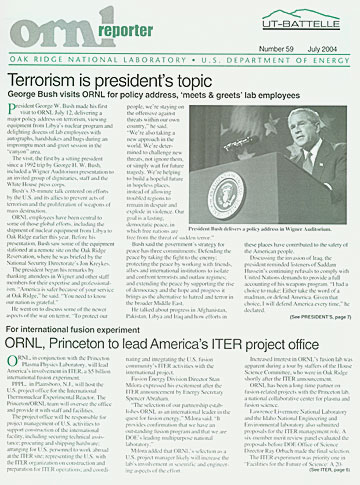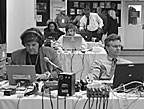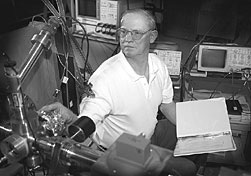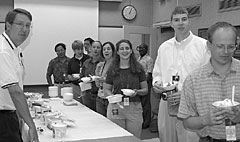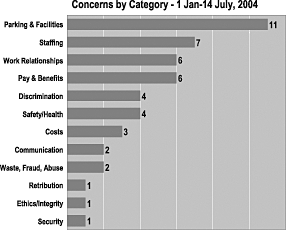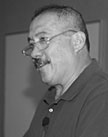Number 59, July 2004
New Staff Members Lab Notes Concerns coordinator welcomes employee suggestions
lab programming‘Last 9/11 survivor’ tells how ORNL can aid in rescue efforts
Terrorism is president’s topic
George Bush visits ORNL for policy address, ‘meets & greets’ lab employees
President Bush delivers a policy address in Wigner Auditorium. President George W. Bush made his first visit to ORNL July 12, delivering a major policy address on terrorism, viewing equipment from Libya.s nuclear program and delighting dozens of lab employees with autographs, handshakes and hugs during an impromptu meet-and-greet session in the .canyon. area.
The visit, the first by a sitting president since a 1992 trip by George H. W. Bush, included a Wigner Auditorium presentation to an invited group of dignitaries, staff and the White House press corps.
Bush.s 35-minute talk centered on efforts by the U.S. and its allies to prevent acts of terrorism and the proliferation of weapons of mass destruction.
ORNL employees have been central to some of those global efforts, including the shipment of nuclear equipment from Libya to Oak Ridge earlier this year. Before his presentation, Bush saw some of the equipment stationed at a remote site on the Oak Ridge Reservation, where he was briefed by the National Security Directorate.s Jon Kreykes.
The president began his remarks by thanking attendees in Wigner and other staff members for their expertise and professionalism. .America is safer because of your service at Oak Ridge,. he said. .You need to know our nation is grateful..
He went on to discuss some of the newer aspects of the war on terror. .To protect our people, we.re staying on the offensive against threats within our own country,. he said. .We.re also taking a new approach in the world. We.re determined to challenge new threats, not ignore them, or simply wait for future tragedy. We.re helping to build a hopeful future in hopeless places, instead of allowing troubled regions to remain in despair and explode in violence. Our goal is a lasting, democratic peace, in which free nations are free from the threat of sudden terror..
Bush said the government.s strategy for peace has three commitments: Defending the peace by taking the fight to the enemy; protecting the peace by working with friends, allies and international institutions to isolate and confront terrorists and outlaw regimes; and extending the peace by supporting the rise of democracy and the hope and progress it brings as the alternative to hatred and terror in the broader Middle East.
He talked about progress in Afghanistan, Pakistan, Libya and Iraq and how efforts in these places have contributed to the safety of the American people.
Discussing the invasion of Iraq, the president reminded listeners of Saddam Hussein.s continuing refusals to comply with United Nations demands to provide a full accounting of his weapons program. .I had a choice to make: Either take the word of a madman, or defend America. Given that choice, I will defend America every time,. he declared.
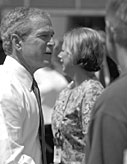


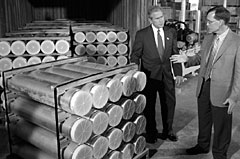


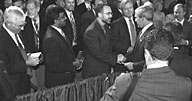
President’s visit provides memorable moments .Today, because America has acted against these dictators, and because America has led, the forces of terror and tyranny have suffered defeat after defeat, and America and the world are safer,. the president said.
Bush also discussed possible difficulties ahead, citing efforts to convince the leaders of North Korea and Iran that their nuclear weapons ambitions are .deeply contrary to their own interests.. He mentioned the need to finish the work related to America.s Broader Middle East Initiative, efforts toward building a free and democratic Palestinian state that lives in peace with Israel, and commitments to help Afghanistan and Iraq build the world.s newest democracies.
.We have strong allies, including millions of people in the Middle East who want to live in freedom. And the ideals we stand for have a power of their own,. he said. .The appeal of justice and liberty, in the end, is greater than the appeal of hatred and tyranny in any form. The war on terror will not end in a draw, it will end in a victory, and you and I will see that victory of human freedom,. the president concluded, to vigorous applause.
After greeting some of those gathered in Wigner Auditorium, Bush slipped out of the room.headed, most thought, for his limousine. He was not quite ready to leave the lab, however, and spent some 10-15 minutes with surprised and excited employees who quickly gathered in the canyon between Bldgs. 4500N and 4500S to meet the president.
Security officers grabbed hand-held metal detectors and hurriedly screened lab staff members who streamed out of the 4500 complex as word spread. Bush greeted employees, shook hands, gave some hugs and signed everything in sight.from badge attachments to business cards to a photo of the grandson of ORNL.s Jim and Brenda Hackworth.
Secret Service agents watched patiently in the midsummer heat, and National Security Adviser Condoleeza Rice waited in the limo as the president, in shirtsleeves, worked the crowd much like an athlete or an entertainer.Sharpie in hand. It was a memorable moment for many.
~~~~~ Preparations for the president.s Monday visit had began the previous Thursday and continued throughout the weekend. Advance team members scrutinized details for matters as grave as ensuring the president.s safety to providing coffee for the several busloads of media. Members of the press corps included local media as well as the five major networks, The New York Times, USA TODAY, and the L.A. Times.
The troupe also included reporters from Mideastern news agencies Al Jazeera, Alhurra and Al Arabiye. .That.s unusual for them to come,. said a member of the support crew. .They came because it was at Oak Ridge..
~~~~~ An unsung hero of the Bush visit is also everybody.s best friend in the summertime.the air-conditioning maintenance guy.
July 12 was hot and muggy. Wigner Auditorium, packed to capacity for at least two hours before the talk, felt great. And Wigner has the reputation for becoming stuffy when the seats are full.
Matthews Facilities and Operations. Wayne Matthews said he received orders to give Wigner .all we had. that morning. That included blocking vents open all the way and pushing the cooling system, in which air is blown over condensers in the basement of Bldg. 4500-North, as hard as it would go toward the auditorium.
Matthews tends, nearly single-handedly, to the HVAC systems for the entire 4500 complex, assisted by Ricky Madison and Reggie Thompson. It.s not unusual to see him bathed in sweat while he keeps labs and offices cool.
.He knows his stuff,. said Facilities Management Division Director Jimmy Stone.
~~~~~ ORNL Protocol Officer Nancy Gray received a call from the White House advance team leader at the end of the visit, thanking her and the rest of the lab for what was, for the advance team, a smooth and relatively easy event.
ORNL.s location, particularly its security setup, is ideal for such occasions, and the lab.s experience with events was apparently evident to the advance and security teams..Reported by Cindy Lundy and Bill Cabage
For international fusion experiment
ORNL, Princeton to lead America’s ITER project office
ORNL, in conjunction with the Princeton Plasma Physics Laboratory, will lead America’s involvement in ITER, a $5 billion international fusion experiment.
PPPL, in Plainsboro, N.J., will host the U.S. project office for the International Thermonuclear Experimental Reactor. The Princeton/ORNL team will oversee the office and provide it with staff and facilities.
The project office will be responsible for project management of U.S. activities to support construction of the international facility, including securing technical assistance; procuring and shipping hardware; arranging for U.S. personnel to work abroad at the ITER site; representing the U.S. with the ITER organization on construction and preparation for ITER operations; and coordinating and integrating the U.S. fusion community’s ITER activities with the international project.
Fusion Energy Division Director Stan Milora expressed his excitement after the ITER announcement by Energy Secretary Spencer Abraham.
Stephen Combs, who heads fusion pellet fueling technology activities for ORNL’s Fusion Energy Division, tests equipment that will be used in support of ITER. “The selection of our partnership establishes ORNL as an international leader in the quest for fusion energy,” Milora said. “It provides confirmation that we have an outstanding fusion program and that we are DOE’s leading multipurpose national laboratory.”
Milora added that ORNL’s selection as a U.S. project manager likely will increase the lab’s involvement in scientific and engineering aspects of the effort.
Increased interest in ORNL’s fusion lab was apparent during a tour by staffers of the House Science Committee, who were in Oak Ridge shortly after the ITER announcement.
ORNL has been a long-time partner on fusion-related projects with the Princeton lab, a national collaborative center for plasma and fusion science.
Lawrence Livermore National Laboratory and the Idaho National Engineering and Environmental laboratory also submitted proposals for the ITER management role. A six-member merit review panel evaluated the proposals before DOE Office of Science Director Ray Orbach made the final selection.
The ITER experiment was priority one in “Facilities for the Future of Science: A 20-Year Outlook,” a proposed portfolio of 28 new facilities and upgrades of current facilities that Abraham released in November 2003. The portfolio will serve as a roadmap for future scientific facilities to support DOE’s basic science and research mission and to help the department plan its future scientific investments.
A fusion power plant would produce no greenhouse gas emissions, use abundant and widely distributed sources of fuel, shut down easily, require no fissionable materials, operate in a continuous mode to meet demand, and produce manageable radioactive waste.
ITER construction is scheduled to begin in 2006, with first operations in 2013. Possible sites for the experimental facility are Cadarache, France, and Rokkasho, Japan. The U.S. government supports the Japanese site.
For most significant technological innovations
Lab staff members receive three more R&D 100 awards
Researchers at ORNL have won three more R&D 100 awards, presented annually by R&D Magazine in recognition of the year’s most significant technological innovations.
ORNL’s total of 119 awards places it second only to General Electric.
The honors were for the following inventions:Highly Selective, Regenerable Perchlorate Treatment System, developed by Baohua Gu, Gilbert Brown, Peter Bonnesen and Bruce Moyer of ORNL
The Highly Selective, Regenerable Perchlorate Treatment system uses a unique, highly specific resin to trap the perchlorate, destroy it, and regenerate itself so it can be reused. Perchlorate, the primary ingredient of solid rocket propellant, is increasingly being discovered in soil and water. The chemical disrupts function of the human thyroid gland, which regulates metabolism in adults and physical development in children.
The system created by ORNL uses a process known as selective ion exchange, which is the preferred treatment technology for removing contaminants such as perchlorate from water However, the resins often absorb chemicals other than those targeted for cleanup. They also become contaminated and must be disposed of, destroyed or stored, which is costly and often impractical.
The reaction in the ORNL treatment system that destroys the perchlorate also produces a chemical that regenerates the resin, breaking the perchlorate down into harmless chloride and water. The result is an 80 percent reduction in costs over other ion exchange procedures and elimination of the problem of secondary waste.
Advanced Heating System for High-Performance Aluminum Forgings, developed by Craig Blue, Puja Kadolkar, Peter Engleman, Charles Howell, Jackie Mayotte, Vinod Sikka and Evan Ohriner of ORNL; Robert Kervick of Komtek of Worcester, Mass.; Howard Mayer of Queen City Forging Company of Cincinnati; George Mochnal of Forging Industry Association of Cleveland; Teiichi Ando and Hui Lu of Boston’s Northeastern University; and Charles Blue of Infrared Heating Technologies of Oak Ridge
The Advanced Heating System uses an optimized combination of radiant and convection heating for processing materials. When used to heat aluminum billets, the system reduces heating time and energy consumption and produces high-performance forgings with significantly improved tensile and fatigue properties, compared with those heated by conventional techniques.
High-performance aluminum forged components are lightweight and can serve as a less costly substitute for titanium and other expensive components in automotive and aerospace applications. The Advanced Heating System also offers potential applications in other thermal processes, including joining and heat treatment, and can be tailored to process additional materials such as steel, titanium and nickel-based alloys.Explosives Vapor Sensor, developed by Thomas Thundat, Lal Pinnaduwage, Tony Gehl, Vassil Boiadjiev and Eric Hawk of ORNL; David Hedden of the University of Tennessee; Eric Houser of the Naval Research Laboratory; Linda Deel of the Bureau of Alcohol, Tobacco, Firearms, and Explosives; and Richard Lareau of the Transportation Security Administration
The Explosives Vapor Sensor is a compact, low-cost sensor for detecting and locating a variety of explosives, including plastic-based explosives. A micromechanical transducer, no wider than a human hair and with a mass of only a few nanograms, allows only explosive molecules to chemically adsorb to a sensor that can identify the molecule.
SniffEx is an improvement over other explosive detection products (such as gas chromatography/mass spectrometry and gas chromatography/surface acoustic wave devices) because of its sub-part-per-trillion sensitivity and high selectivity, direct vapor sensing, low power consumption (the instrument uses a 9-volt battery), less-than-one-second response time, stability, compact size, and low cost. SniffEx will have applications in counterterrorism, law enforcement, airport safety and humanitarian efforts such as landmine removal.
New Staff Members
ORNL continues to grow. This feature lists new employees at the laboratory. Welcome to all.
Kunlun Hong, Chemical Sciences
Mark Gardner, Computational Sciences & Engineering
Jeffrey Clower, Deborah Curry, Roger Davy, Jessica Hill, Jo Ann Irwin, Tessa Jackson, Danny Light, Jamie Seeber and Terry Wright, Craft Resources
Jason Vann, Engineering Science & Technology
Christopher Rey, Fusion Energy
Morgan Childs, Laboratory Protection
Keith J. Leonard, Metals & Ceramics
Debbie Matteo, National Security Directorate
Sheila Causby, Chad DeGuira, Donna Inman, Cynthia Latham and Nancy Spiers, Networking & Computing Technologies
Kevin Clarno, Paula Kirk and Robbie York, Nuclear Science and Technology
Lana Blackwell, Operational Safety Services
Jack Lewis, Records, Training and SBMS Services
Tina Phillips, Research Reactors
Saul Matovu and Michael Plum, SNS Accelerator Systems
Loren Funk, Joerg Neuefeind and Marcus Pope, SNS Experimental Facilities
Thomas Ballard, Technology Transfer and Economic Development Directorat
Bush not the first
This summer’s trip to ORNL by George Bush marked the third time a sitting U.S. president has visited the lab.
President Bush’s father, George H. W. Bush, came to ORNL in February 1992 to witness the signing of a CRADA between ORNL and Coors Technical Ceramics. The ceremony was held outside the High Temperature Materials Laboratory.
President Jimmy Carter, a nuclear engineer, was the first chief executive to visit, making an appearance in May 1978. He asked ORNL and other Oak Ridge staff members to help find solutions to problems plaguing America’s nuclear industry.
Three other public servants who eventually served as president visited the lab during earlier stages of their careers: U.S. Rep. Gerald Ford (1965) and U.S. Sens. John Kennedy (1959) and Lyndon Johnson (1958).
And, as noted by Knoxville News Sentinel senior writer Frank Munger in coverage of the Bush visit, don’t forget Zachary Taylor. Some of Taylor’s remains were here in 1991 so researchers could look for arsenic, using a neutron-activation technique. The analysis, which turned up little arsenic, was conducted in an effort to determine whether Taylor had been poisoned before he died in 1850.
I scream, you scream . . .
The Chemical Sciences Division Council helped fight the mid-summer heat by treating division staff, students and guests to an old-fashioned ice cream social. The annual event is sponsored by the CSD Council, which consists of nine members who collect and act on feedback from their co-workers covering a broad range of improvement activities.
Expressing appreciation with ice cream and toppings has been one of the most popular council actions to date. This summer CSD welcomed 34 students and guests from some 27 institutions.
Help with sci-ed initiative
ORNL and UT-Battelle have joined a DOE initiative to promote science literacy and help develop the next generation of scientists and engineers.
“There is plenty of evidence that we need to do a better job of teaching basic science education to our young people,” Lab Director Jeff Wadsworth said. “As one of the world’s leading centers of scientific research, ORNL seeks to be East Tennessee’s foremost advocate and supporter of science education.”
Wadsworth said UT-Battelle divides its science education efforts into three categories.
“We are helping expand the number of accredited science teachers by funding the UT summer science education workshop for middle school science teachers. For students, UT-Battelle offers more than 100 summer intern slots at the lab, summer camps and environmental classes for elementary students, science scholarships to UT, and support for high school science competitions.
“Perhaps most importantly, we have provided approximately $230,000 to fund new science labs in 23 Tennessee schools. Together, these initiatives are making a real difference in the quality of science education in East Tennessee,” he said.
Hang onto those toes
The Engineering Science and Technology Division hosted a welcome luncheon for their 48 summer students and faculty. Division Director Ted Fox encouraged the guests to have an enjoyable research experience, to work safely, “returning home just as they came, with all of their fingers and toes intact,” and to take advantage of the workshops and seminars offered to them.
Guest speakers included Lee Riedinger, deputy director for science and technology, and Linda Holmes of ORISE’s Science and Engineering Education group. ESTD’s student and faculty population represents many colleges and universities, as well as Oak Ridge High School’s Southeastern Consortium for Engineering and Minorities Program.
ORNL assist to Cassini
As you enjoy the incredible photos from NASA’s Cassini-Huygens spacecraft that recently entered Saturn orbit (such as this image of Saturn’s rings, draped by the shadow of Saturn), remember that ORNL played a crucial role in that mission’s success. The laboratory, under a program managed previously by the Metals & Ceramics Division’s Peyton Moore and now by Jim King, developed the iridium cladding for the plutonium fuel cells that power the spacecraft’s instruments. The radioisotope thermoelectric generators convert heat from the cells’ plutonium oxide fuel into electricity to power the spacecraft’s systems.
The iridium cladding design is highly impact resistant, providing a necessary safety feature in the event of a liftoff failure or unplanned reentry during a gravitational-assist flyby.
Most of ORNL’s work for the Saturn mission occurred years ago. Cassini-Huygens lifted off without incident in 1997. “People worked their tails off on that project,” recalled Moore, now retired. But ORNL is still bound for space: Fuel-cell components are being made in Bldg. 2525 for upcoming deep space missions, including NASA’s New Horizon mission to Pluto and beyond, set for 2006.
‘Major sea change’
The lab received some positive news during recent exit briefings by members of the OA-40 inspection team. The OA-40 audit is an external assessment of how well ORNL is implementing Integrated Safety Management.
Glenn Podonsky, director of Independent Oversight and Performance Assurance, noted that ORNL has demonstrated a “major sea change in culture” since the team’s last visit in 2001. Tom Staker, OA-40 team lead, recognized UT-Battelle for making significant progress in many areas such as processes, organization, culture and reduction of hazards.
The team also agreed with ORNL management’s own recognition that the lab has many opportunities to improve. ORNL will submit its corrective action plan on the findings.
—Reported by Cindy Lundy and Bill abage
Concerns coordinator welcomes employee suggestions
Kendrick Parking. Overhead costs. Benefits changes.
Although she says she’s “really just getting started” with the assignment, ORNL Concerns Program Coordinator Cindy Kendrick can readily recite a litany of issues raised by lab staff members so far in 2004.
Kendrick, who was named to the position in January, has received nearly 50 “official” concerns, with many related to facilities and parking, relationships with supervisors and co-workers, staffing processes, and changes to the employee benefits program.
Her program is an independent function with direct and ready access to the Laboratory Director’s Office. It was established as an outgrowth of the “Quality of Work Life” surveys, last conducted in 2001.
“The most recent survey indicated that fear of retaliation was still a significant issue at ORNL, and a focus group was established to interview staff members, analyze the situation and make recommendations,” Kendrick said. “The feedback indicated the need for a clearer and better-advertised avenue for employees to express and management to receive concerns.”
Kendrick explained that her program is not meant to supersede interactions between employees and their supervisors. “We encourage staff members to first take their concerns to their supervisors or line management. These folks most likely are in the best position to address them,” she said. “The next tier would be the functional groups, such as the Diversity Office, Safety, and Audit & Assessment—the people who are experts in the field of concern.
“But if staff–UT-Battelle employees or others working on-site—don’t know where to take their concerns, if they’ve been to those places and are not satisfied that they have actually been heard, or if they’re not comfortable with those places, they can come to me,” Kendrick said.
She explained that in most cases, if there are not confidentiality issues, she can refer them to the experts, ask questions and make sure they get to the right places. “If they are not comfortable doing that themselves, I do it for them and keep their identities confidential.”
Kendrick added that the program’s independent reporting relationship to the Lab Director’s Office allows her access to Director Jeff Wadsworth and Deputy Directors Lee Riedinger and Jeff Smith when needed. “Most of the time I’m able to work the issue with the functional areas or a Level 1 manager, but I am free to consult with Jeff, Lee or Jeff when it’s necessary,” she said.
“So far the cooperation with the functional groups, areas of expertise and management has been impressive. Everyone has been eager to address the concerns—to hear the issue, understand it and try to address it,” she said. “We can’t always make everybody happy, but we can at least help people understand that they have been heard at the right level. And sometimes we hear things that we need to change.”
Kendrick is preparing regular reports for the lab’s Leadership Team on the numbers of issues and concerns she encounters, as well as on emerging trends. “I’m also trying to include information about things that I just ‘hear.’ I’ve been out talking to various groups of employees, and many have opened up and told me what’s on their minds. I think this information is extremely important for our management to have.”
She also plans to communicate with employees about general issues and trends she has encountered via website, ORNL Today, Reporter and other media.
Regarding specific issues and concerns, Kendrick said a dominant one during her short tenure has related to facilities and parking. “People in new facilities have had parking concerns; those who are not in new facilities want to know—are we going to have services and improvements in our areas? Of course, there is an impressive plan for development of the ORNL West End, and they are looking at inclusion of amenities in those planned facilities. These issues certainly impact employees’ everyday work lives, and they are of concern.”She said employees also have questions about costs and benefits. “Cost is another big thing. When are we going to bring our overhead down? There also have been quite a few concerns about changes in benefits, including medical plans, with some confusion over doctors and services.
“Another area is communication. People are asking for more direct communication. What I’m hearing is that folks want more contact with upper management—through staff meetings, ‘walkabouts,’ and whatever media allow them to see and hear directly,” she added.
When asked what has surprised her since she began her assignment, she cited the hesitancy of many employees to use their names when expressing a concern. “About half of those bringing concerns have asked me not to use their names, even for some issues that don’t appear to be sensitive. They worry that speaking up might impact their relationships with supervisors or co-workers, or that they’ll be branded as troublemakers. Some fear that they will receive undesirable assignments, be ostracized or passed over for opportunities, or even lose their jobs.“I’m glad to be able to work these issues for folks and keep them confidential. There may be situations where safety or legal imperatives preclude confidentiality, and I tell them right up front. Otherwise, I’m happy to work their issues confidentially.
“We really just want them to speak up,” Kendrick said. “The most important thing is that the concern be raised. I hope folks will consider that this office is extremely sensitive to the issue of confidentiality and very concerned about establishing and maintaining trust. I’m hopeful that we can better understand what’s behind the fears and work on those issues as well.
“Although there may be some issues that the process cannot fix, frequently we can at least make some improvements,” she continued. “It may not always be immediate; sometimes we have to chip away at it. But if we hadn’t been made aware, we couldn’t do anything.”
Kendrick added that she is enjoying her assignment. “I really like talking to people and hearing what they have to say. And since it’s a new role for me, I welcome new ideas, suggestions and feedback. It’s important for all of us to try to improve.”
For more information on the Employee Concerns Program, contact Kendrick (241-CALL or concerns@ornl.gov) or visit the website at http://home.ornl.gov/concerns.
‘Last 9/11 survivor’ tells how ORNL can aid in rescue efforts
Fuentes Some people might say Al Fuentes is lucky to be alive.
But Fuentes, retired after 26 years with the NY Fire Service, said ORNL research can take luck out of the equation when it comes to protecting and helping rescue workers.
The last survivor retrieved from the ruins of 9/11, Fuentes remained in a coma for two weeks as he was treated for collapsed lungs, brain trauma, broken ribs and other injuries.
He was found when a fellow rescuer spotted his right hand protruding from the rubble.
Fuentes recounted his experience at the National Security Directorate’s June huddle, saying ORNL technology can help make such rescue efforts more successful.
“I honestly feel that you [ORNL researchers] are going to be directly responsible for helping first responders in their colossal job in the fight against terrorism,” Fuentes said, explaining that ORNL technologies in sensors, communications, insulated materials and thermal imaging must be integrated into rescue efforts.
Rescue applications he cited for those technologies include:
*Sensors to identify victims with special needs, such as pregnancy or handicaps.
*Imaging devices to locate large groups of survivors trapped in certain parts of a building.
*Structural alarms to warn rescuers of building shifts, cracks or imminent collapse.
Fuentes spent most of his career in elite rescue units in Manhattan and Brooklyn. He was a search team manager on one of the 28 rescue teams at the Oklahoma City bombing.
A longtime advocate of technology to protect rescuers working in wrecked buildings, Fuentes in 1997 patented a video computer device designed to alarm when a damaged building shifts.
“Today’s first responders are using 20th century technology to deal with 21st century terror,” Fuentes said. “We have cars with navigation systems that give you directions to anywhere in the world, but we can’t find a human in the rubble; we talked to men on the moon 38 years ago, yet I could not talk to my men two floors up.
“When terrorists are inside our homeland, this technology is serious business.”
Fuentes has written a book on his experiences as a 9/11 victim and a firefighter titled “American by Choice” (Atlas Books). It will be released Sept. 11.–Mike Bradley
ORNL people
The Nuclear Science and Technology Division’s Emory Collins received the Glenn Seaborg Actinide Separations Award for 2004. The award was presented at the Actinide Separations Conference.
Kim Sang-ho Kim of the Spallation Neutron Source’s Accelerator Systems Division has won the 2004 Outstanding Young Researcher Award of the Association of Korean Physicists in America. The committee noted Kim’s outstanding contribution to superconducting cavity research. The honor comes with a $1,000 cash award.
Battelle Memorial Institute has recognized Inventors of the Year from Battelle, PNNL and ORNL. Thomas Thundat, named ORNL’s Inventor of the Year at UT-Battelle’s 2003 Awards Night, was recognized “...for the development of a new paradigm for achieving biomolecular transport and separation using optical manipulation of surface charge.” Thundat also was presented the Pioneer Award by the Nanotechnology Institute of the American Society of Mechanical Engineers. The award was presented in celebration of the 10-year anniversary of molecular recognition with micro- and nanocantilevers. Thundat was cited “for pioneering this field of nanomechanics, which promises to impact the health, wealth, and safety of mankind.”
Denny Jackson of the National Security Directorate has been selected to receive the National Cargo Security Council’s highest award. The NCSC’s citation recognizes the retired Army major general’s “skillful management of the largest, most successful, and efficient transfer of materials and equipment in the shortest time span in military history, as the Director of Logistics and Engineering for all of Southwest Asia, with emphasis on Operation Enduring Freedom and Operation Iraqi Freedom in the liberation of Afghanistan and Iraq.”
Brooks The Environmental Sciences Division’s Scott Brooks has received the division’s Distinguished Scientific Achievement Award. The award recognizes notable achievement in research as exemplified by open-literature publications that promote awareness of and solutions for environmental challenges. Brooks was selected by his ESD colleagues for his outstanding research on the influence of coupled hydrological and geochemical processes on the bioreduction of redox-sensitive, chelated inorganic contaminants in porous media.
The Fusion Energy Division’s Nermin Uckan has been appointed to the International Advisory Committee for the Journal of the Korean Nuclear Society (South Korea). Uckan is also the editor of Fusion Science and Technology, an international journal of the American Nuclear Society.
Felix Paulauskas of the Metals & Ceramics Division is being honored as co-author of the Outstanding Technical Paper at the Society for the Advancement of Material and Process Engineering 2004 International Symposium and Exposition. The paper is entitled “Structure and Properties of Carbon Fibers Produced Using Microwave-Assisted Plasma Technology: Part 1” and provides information on fibers produced using new processes developed by ORNL as part of the DOE Automotive Lightweight Materials Program.
Downer Rodriguez Karen Downer has been named deputy director for the Environment, Safety, Health & Quality Directorate. In this new position, she reports to Kelly Beierschmitt. Downer has been at the laboratory since 1997 and had been director of the Environmental Protection and Waste Services Division since April 2000.
Miguel Rodriguez has been named manager of the ORNL Bioprocessing User Facility, replacing Brian Davison, who now directs the Life Sciences Division. Rodriguez came to ORNL in 1989 as an intern and most recently was a research associate in Life Sciences’ Biochemical Engineering group.
The American Ceramic Society has published a book, “Fabrication of Long-length and Bulk High Temperature Superconductors,” co-edited by Amit Goyal of the Metals & Ceramics Division. The book is a summary of developments in high-temperature superconductor research.
It’s ‘safety first’ for laboratory’s summer students
Practicing safe working habits at ORNL should be like putting on your seatbelt when you leave for work.
You should always think of it first.
Raising summer students’ awareness of lab safety issues was the goal of the recent Safety Awareness Luncheon on Main Street.
“Whether you’re working in a lab or an office environment, you’ll face hazards,” said Operational Safety Services Division Director Carol Scott. “We’re concerned about every person who comes in, and this seemed like a good way to get in touch with our students.”
Some 450 summer students and mentors attended the annual luncheon as part of the “Safety 1st” program presented by OSSD.
Safety 1st is a monthly program that focuses on current safety issues. It uses various types of communication methods such as posters, announcements and speakers to disseminate information about pertinent ORNL safety topics.
While students are not full-time ORNL employees, they are an important group of workers. OSSD staff and the lab’s Leadership Team want them to be aware of their responsibilities for a safe work environment.
“Because temporary employees usually are not familiar with processes and hazards here, we want to raise their awareness,” said Jim Goodpasture, Health and Safety Services group leader. “We don’t want them to fall through the cracks because of their temporary status.”
By targeting a Safety 1st program to students, Scott said she wants students to not only be aware of the importance of safe working practices, but also to know where to go if they have safety concerns.
“We want to make sure they get their answers and that their concerns get to the right audience,” she said.
One of the audiences for concerns is student mentors. The student-mentor relationship provides a means for interns to learn about safety procedures at the laboratory and to voice concerns if they feel that their safety is in jeopardy.
“The environment you’re in is probably different from the environment you’re used to. Mentors can help orient you,” said Jim Roberto, associate laboratory director for Physical Sciences, who was a guest speaker at the luncheon.
Roberto said he sees having a safety mindset as a protective barrier–not unlike a safety belt–between workers and the laboratory environment.
“There might be a one in a thousand chance that you will get hurt without such a barrier, but there’s only a one in a million chance you will get hurt with the barrier of safety in place,” he said. “We want to send you home in the same condition as you arrived.”
Lab officials said they hope that emphasizing safety to the students now will help make them more aware of safety issues throughout their lives.
“We want to help ensure good safety habits for use throughout their careers, serving them at home and on the job,” Scott added.—Amy Merrick
[Amy Merrick is an intern from the University of Tennessee science writing program.]
Jim Beene, Steve Zinkle are new corporate fellows
Beene Zinkle Physicist Jim Beene and materials scientist Steve Zinkle have been named UT-Battelle corporate fellows in recognition of their sustained and outstanding research contributions at ORNL.
Corporate fellows are selected for their significant work over many years and are acknowledged by their peers throughout the United States and other nations.
Beene has been director of the laboratory’s Holifield Radioactive Ion Beam Facility (HRIBF) since 1995. He was selected for his pioneering and seminal work in nuclear structure physics and for directing HRIBF to become a forefront facility for nuclear science. He is credited with developing an isotope-separator-on-line facility, which enhanced its capabilities as a national user center for scientists from outside institutions to conduct physics and nuclear-related research.
Beene has been with ORNL’s Physics Division since 1976. Among his concentrations of work is the study of the excitation and decay of nuclei in neutron-rich radioactive species.
He earned a bachelor’s degree from the University of the South and was awarded a master’s in physics and doctorate in nuclear physics from the University of Oxford.
Beene and his wife, Elaine, reside in Oak Ridge. They have three children.
Zinkle, leader of the nuclear materials science and technology group in ORNL’s Metals and Ceramics Division, is considered an international authority in the study of radiation effects on materials. He has written a series of critical review articles summarizing fundamental radiation effects aspects in a broad range of metals and ceramics.
He has co-authored more than 140 peer-reviewed journal papers and 42 papers in books from conference proceedings. His expertise in electron microscopy and knowledge of radiation effects have enabled him to develop collaborations with scientists outside ORNL, including work with institutions in the United States, Germany, Switzerland and Denmark.
Zinkle joined ORNL as a Wigner fellow in 1985. He received bachelor’s and master’s degrees and a doctorate in nuclear engineering, as well as a master’s degree in materials science, from the University of Wisconsin.
He is married with two children and resides in Knoxville.
Team UT-Battelle Corner
Team UT-Battelle volunteers have been busy raising funds to help improve lives.
The team participating in Anderson County’s Relay For Life for the American Cancer Society raised more than $11,500, said team coordinator Scott Branham.
Donations included themed basket sales, individual contributions and sales of the infamous “potato cocktails” that Team UT-B has served for the past three years.
~~~~~ More than 65 Team UT-Battelle walkers engaged in a celebration of diversity and fund-raising for the National Conference for Community and Justice in Knoxville.
The team turned in almost $4,000 to support NCCJ’s programs, which are designed to promote skills among youth, community leaders and educators to build a more just and inclusive society. Overall, 400 walkers raised $29,000.
~~~~~
The Tour de Cure bicycle ride to raise money for the American Diabetes Association was a great success, with more than $180,000 in pledges.
Team UT-Battelle won the largest team award (39 riders) for the third straight year and had the most money pledged, with a total of $11,157, said team organizer Bruce Siefken.
~~~~~
Lonna Cotter, Team UT-B coordinator for the JDRF Walk to Cure Diabetes, thanked the ORNL team captains and walkers who helped make it such a successful event.
The first ORNL soccer game for the JDRF featured the Leadership Team, coached by Lee Riedinger, vs. “The Others,” coached by Costas Tsouris. The final was 4-1, “The Others.” Donations from the walk and the game exceeded $3,600.
~~~~~
More than $1,000 was raised by Team UT-Battelle walkers during the March of Dimes of Anderson County’s Walk America.
The March of Dimes supports research and education to reduce the number of low-birth-weight and prematurely born babies. ORNL’s Fred Strohl co-chaired this year’s walk.
Cindy Lundy, lead editor, ORNL, 865/574-1642 (lundycr@ornl.gov)
Deborah Barnes, associate editor, 865/576-0470 (barnesds@ornl.gov)ORNL office: P.O. Box 2008, Oak Ridge, TN 37831-6146, Building 4500-S, Room F-60, MS 6146
DOE inspector general hotline: 1-800-541-1625
[an error occurred while processing this directive] [an error occurred while processing this directive]


